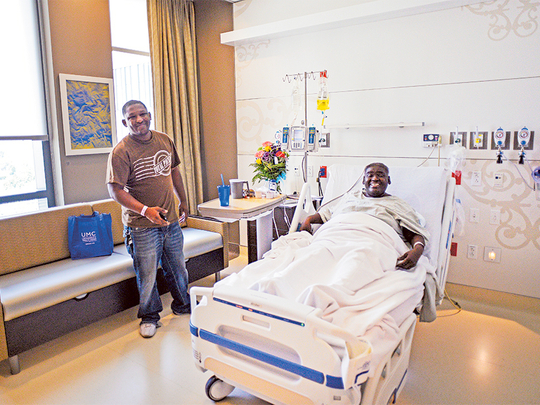
New Orleans: Ten years after the levees and floodwalls broke during Hurricane Katrina and flooded New Orleans, the city finally has a full-scale hospital again.
The new 0.7 million metre University Medical Centre (UMC) New Orleans opened on Saturday morning, built with $1.1 billion (Dh4 billion) of federal, state and private rebuilding money. Ambulances and medical staff began the transfer of 131 patients into the new hospital for its first day of operations. Orchestrating the move required closing down streets as ambulances take patients into the facility.
In addition, the system’s 2,000-strong staff of doctors, specialists, nurses and office workers will move in too.
Since Katrina’s floodwaters devastated the city in 2005, medical services have been scattered. The opening of the UMC complex — an artfully designed state-of-the-art hospital — signals a return to top-notch medical care in the city.
The hospital will serve anyone, whether they can pay or not, it has promised.
The UMC complex is the successor to the towering 1930s-era Charity Hospital, a 0.3 million metre Art Deco downtown institution much loved in New Orleans. In tandem with the UMC campus, a new adjacent US Department of Veterans Affairs hospital is slated to open next year.
The move to not reopen Charity — over the objections of many — and build a new hospital district was anything but easy. City, federal and state officials forced hundreds of homeowners and businesses to relocate from neighbourhoods founded by a mix of European immigrants — Jews, Germans and Eastern Europeans — and African-Americans. Angry protests, allegations of wrongdoing, lawsuits and evictions ensued.
Although blighted, the neighbourhood was famous for several notable landmarks including the Deutsches Haus, the Dixie Brewery and its Nick’s Bar, numerous elegant homes and its Jazz-era lore. Pockets of resistance held out until the bulldozers came in.
Even before Katrina struck in August 29, 2005, developers had tagged the area as prime for redevelopment into a biomedical corridor. With a price tag at $2 billion, the hospital corridor is one of the largest public works projects undertaken during the reconstruction from Katrina.
The UMC complex is as much a hospital as an architectural endeavour and civic statement. It is a lavish expression of glass chandeliers, space-age like furniture, silent Buddhist-like ponds — all under soft lighting and splashed with soft colours. Critics have said its exteriors do not fit in New Orleans.












